
Big Merp enjoys hanging on the synth side of the studio among the cat tchotchkes. He blends in quite well behind the main modular system, next to a Moog Mother-32 and our Roland VP-03 vocoder.

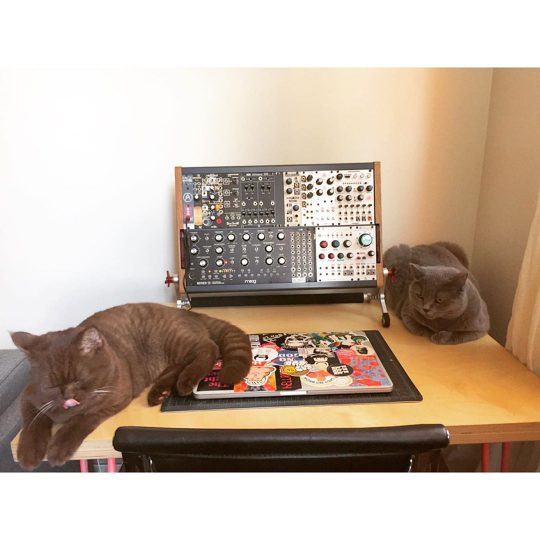
Zelda the Gray returns with her friend Murphy Brown and a modular system. I see a Moog Mother-32 along with offerings from Roland, Mutable Instruments, Sputnik, Make Noise, and more, housed in a 6U Arturia Rack Brute case. From zeldagraymurphybrown on Instagram.

Max, with his lovely marble markings, explores the studio. He is walking past an impressive collection of Eurorack modules, stepping on an Arturia BeatStep, and about to tweak some patches on the Behringer Model D. From coresect23 on Instagram.
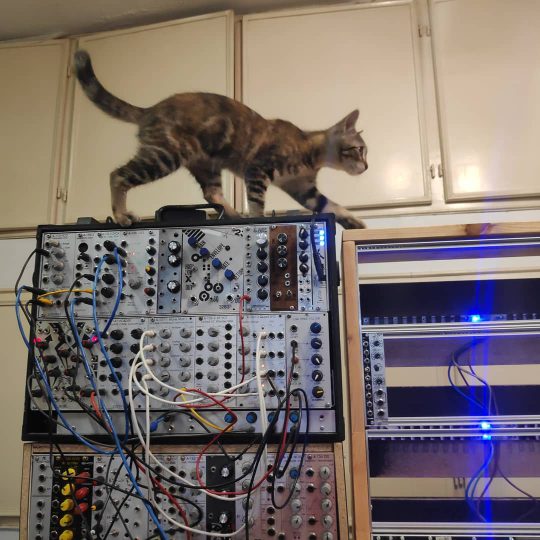
Lilly scampers on top of a Eurorack system that is still brimming with potential. From coresect23 via Instagram.
I have attended the Garden of Memory at the Chapel of the Chimes in Oakland many a summer solstice since moving to San Francisco – and written multiple reviews on these pages and even presented a CatSynth TV showcase last hear. But 2019 is the first time I have performed at this annual event as a named artist. It’s a very different experience from the inside looking out. This article describes the adventure.
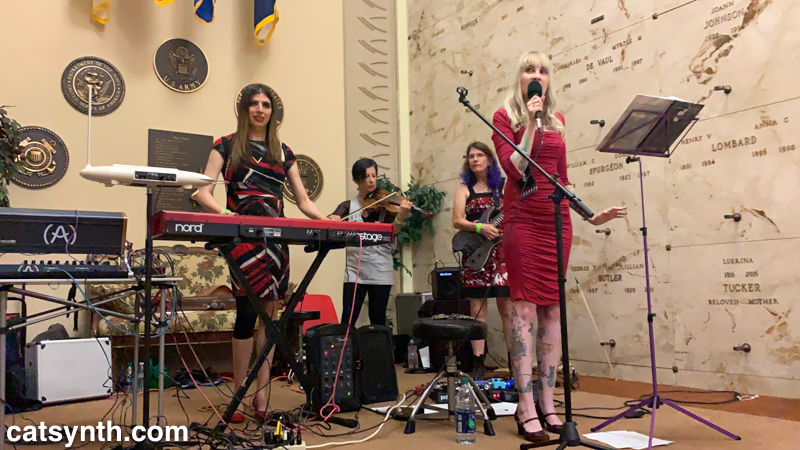
My friend and sometime collaborator Serena Toxicat and I were excited to be accepted into this years program for our project Manul Override. We joined forces once again with Melne Murphy on guitar and also invited Thea Farhadian to sit in with us on violin.
I had a rather elaborate setup, anchored as usual by my trusty Nord Stage EX. The Sequential Prophet 12 has also become a mainstay of my smaller collaborations, providing rich ambient sounds. The Arturia MiniBrute 2, Moog Theremini, and a collection of Eurorack modules rounded out the rig.
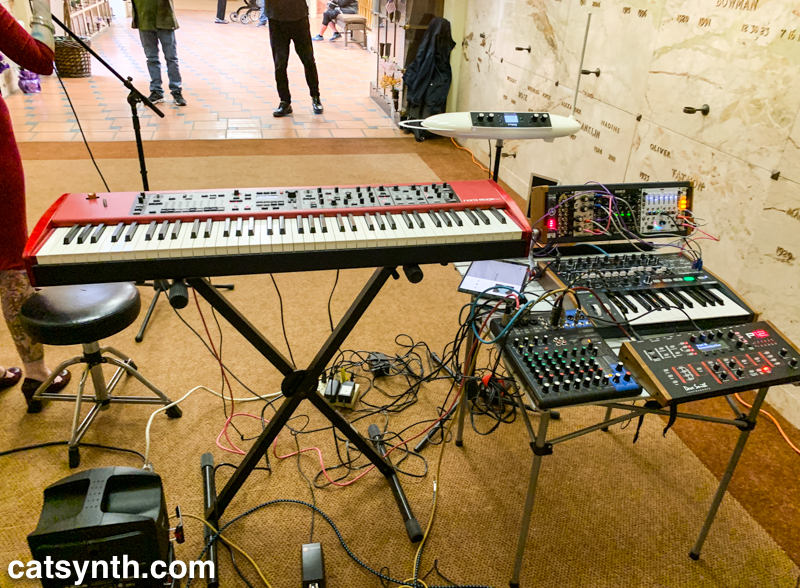
Getting everything into place in the catacombs-like building – a renowned landmark designed by Julia Morgan – was a challenge in itself. Fortunately, I found parking nearby and was able to load everything onto carts or wheeled cases, and had plenty of help getting things downstairs where we were playing.
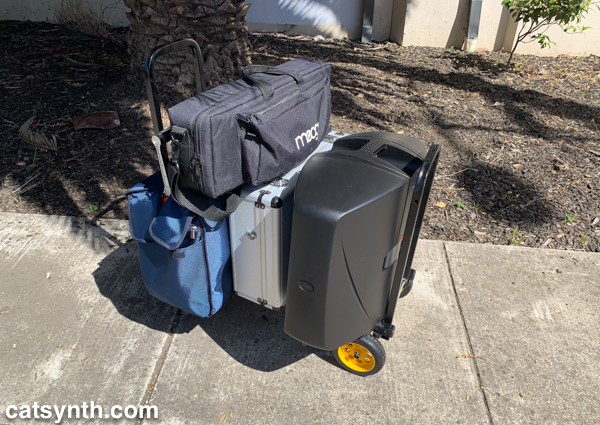
The acoustics of the space are also quite challenging. It is a set of oddly shaped stone chambers, some large, some small, so echoes abound from both the crowds and other performers. Figuring out how to balance our sound is not easy, and I don’t pretend to have gotten it right on the first try, but it’s a learning experience. But we did get ourselves sorted out and ready to play.
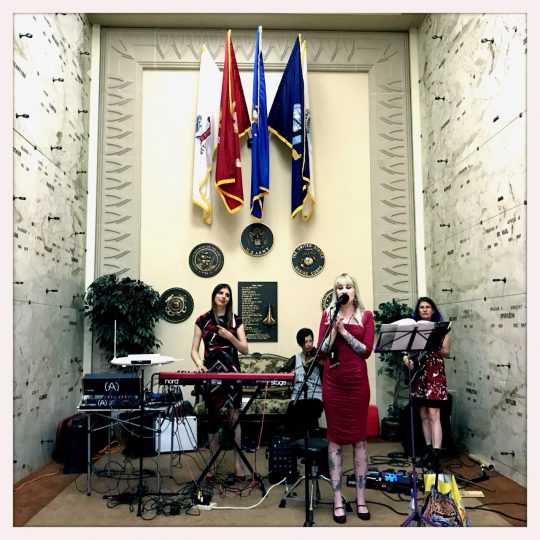
The set unfolded with an invocation, a drone in D mixolydian mode set to Serena’s text Mau Bast, read first in French and then in English. It seemed a perfect piece for the occasion. We then switched things up with a more humorous piece (Let’s Hear it for) Kitties, which was a crowd favorite. You can hear a bit of it in this video from the event.
I have learned how to best follow Serena’s style of speaking and singing, with a more open quality; and Melne and I know how to work together well both in terms of timing and timbre. Thea’s violin added an interesting counterpoint to the voice and electronics. Her sound was sometimes masked by the other instruments and the acoustics but when it came through it added a distinct character and texture. The remaining two pieces were more improvised. One was a free improvisation against one of Serena’s books Consciousness is a Catfish, and another was based on a graphical score with 16 symbols that I first created in 2010 but have revised and reused over the use. The newest version included a cartoon pigeon in honor of my bird-loving co-conspirator Melne.
The performance was well received. Crowds came and went throughout the evening, but many people stayed for extended periods of time to watch us, and others came back a few times. We played two hour-long sets, and in between I had a small amount of time to check out some of the other performs. In particular, I enjoyed hearing Kevin Robinson’s trio, with whom we shared our section of the space.
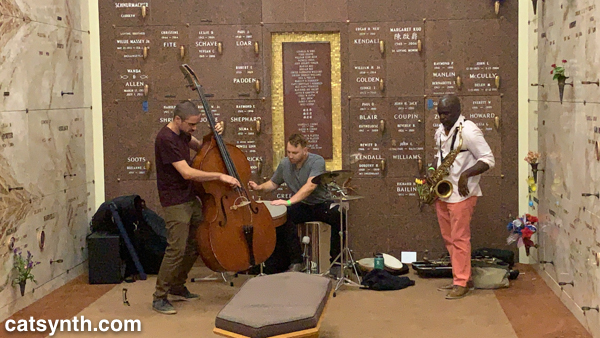
His spare group and arrangements with saxophone, upright bass, and drum, provided a distinct contrast to our thick sound. The moved between long drawn-out tones and fast runs with short notes that reverberated around the space in between. Robinson’s music often has a meditative quality, even when it is more energetic, so it fit well.
Around the corner from us was the Stanford Laptop Orchestra (SLOrk). They had a quiet set featuring performs seated on meditation cushions with laptops as well as various percussive objects as sound sources.

I was particularly inspired by Anne Hege and her Tape Machine, an instrument with a free-moving magnetic tape and several heads, pickups and tiny speakers. She sang into it at various points and moved the tape, created an instrumental piece that was part DIY-punk, part futuristic, and somehow quite traditional at the same time.
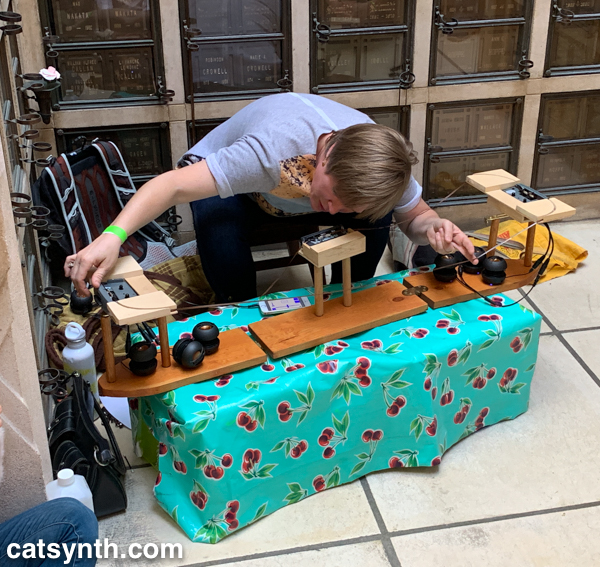
Her performance gave me ideas of a future installation, perhaps even to bring to the Garden of Memory in years to come…
Thea pulled double duty during the evening, also performing as part of a duo with Dean Santomieri, sharing a space with Pamela Z. Our friends Gino Robair and Tom Djll brought the duo Unpopular Electronics to one of the darker columbariums, and IMA (Nava Dunkelman and Amma Arteria) performed on the lower level. In retrospect, our group might have been better placed sharing a space with them, as we are both electronic groups (all women) with large dynamic range.
Overall, it was a wonderful experience, and with the opportunity to play as well as listen it’s my favorite to date. Thank you Sarah Cahill, Lucy Mattingly, and the rest of the crew at New Music Bay Area as well as the Chapel of the Chimes staff for letting us be a part of this event!
One of our first stops at NAMM 2019 was to visit our friends at Qu-Bit Electronix. This year they had three new modules to share.
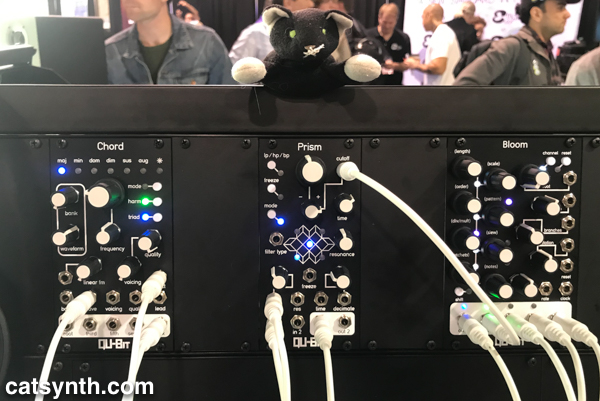
The first of the three was the Prism (center in the picture above). It combines three audio processors that are mapped to a three-dimension “prism” control space. One axis controls a comb filter, another a bit crusher, and the third is time/speed control. The audio processors operate on a buffer, which can either be continuously updated from audio input or “frozen” in time and looped. Finally, there is a
The second module was the Chord, or rather the new incarnation of the chord. It’s a four-voice polyphonic oscillator with both traditional waveforms (continuously morphable) and a new set of wavetables. The oscillators can be stacked into chords, or in this new version each controlled separately for polyphony in the music-theory sense of the word – yes, with the right sequencer, this module can do four-voice counterpoint. The chord mode includes a variety of standard western four-voice chords (i.e., with a seventh degree), but also the ability to add custom chords that include microtones or dense tone clusters. It’s also more compact than the original, slimmed down to just 14hp.
The final module was the Bloom, a sequencer that could generate variations on the fly using a proprietary fractal algorithm. The amount of variation, from none to completely random, can be controlled dynamically via CV, as can the number of steps in the sequence, for quite a range of variety. And with two channels, it would seem to pair nicely the Chord.
As always, it’s fun to visit with Qu-Bit and see what they up to, especially as they are CatSynth superfans. And we look forward to seeing these modules out in the wild over the course of the year. The Prism is due in March, the Chord in late spring, and the Bloom in the fall.
From Polyend on YouTube, via matrixsynth.
“Another piece of sonic adventure from Alna and his helper. Polyend Seq & Poly couple ruling the Eurorack modular and DSI Prophet. Enjoy!”
Here is another video of the Polyend sequencer, sans cat
“Equipped with a wide array of Ins and Outs, allowing you to communicate freely with other devices of every era and genre. You can also feed tracks with MIDI notes using your favorite MIDI controller. Every track can be recorded step by step or in real time and then quantized independently”